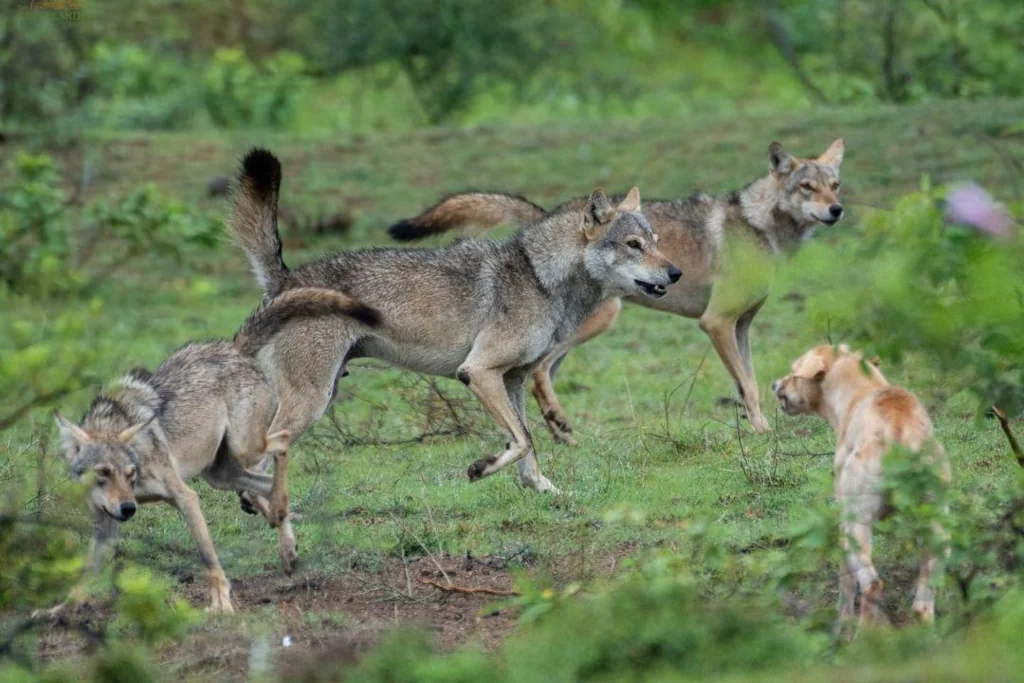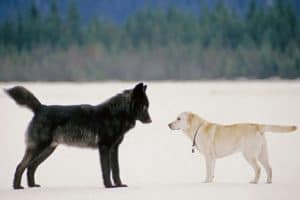So, you’ve gazed at your loyal canine companion and wondered, “Could Rover hold his own among a wolf pack?” This question is rooted in the fascinating relationship between man’s best friend and their wild cousins.
But hey, who wouldn’t be curious about what would transpire if the backyard suddenly turned into ‘The Call of the Wild’?
Let’s scratch beneath the surface of this canine conundrum and uncover what separates your dog from his lupine relatives (that’s just a fancy way of saying ‘wolves’).

Are Dogs and Wolves Really That Different?
Yes, dogs and wolves are quite different, both biologically and behaviorally.
The shared lineage diverged thousands of years ago, and while they’re genetically similar, evolution and domestication have shaped dogs and wolves into distinct animals.
Wolves are wild animals, adapted for survival in tough environments. They’re larger, stronger, and more independent than most dogs. Their social structures, communication methods, hunting strategies, and mating behaviors are fundamentally different.
On the other hand, dogs have been selectively bred for generations to suit human needs. This has led to a wide variety of breeds with an equally varied range of behaviors and abilities. Dogs are domesticated and have evolved to live and work alongside humans.
While a wolf has the wilderness wired into its DNA, your pooch is probably more concerned about the whereabouts of his favorite chew toy.
Could a Dog Join a Wolf Pack?
In theory, it’s possible. In practice, not so much.
A dog joining a wolf pack is a romantic notion, but the reality is much more complex.
Wolf packs are tight-knit family units, centered around a mating pair and their offspring. Each wolf has a specific role within the pack, and they all work together for survival.
An outsider, especially a domestic dog, would have difficulty integrating into this complex social structure. Wolves are also highly territorial, and an intruding dog may be viewed more as a threat than a potential pack member.
Moreover, the behavioral differences between dogs and wolves are stark. The signals and behaviors a dog uses to communicate might not translate well in a wolf pack, leading to miscommunications and potentially dangerous situations for the dog.
So, while it’s a captivating notion, your dog is better off sticking with their human pack.
The World of Canine and Lupine Social Structures
Dog Social Structure
Just as wolves are pack animals, dogs too are inherently social creatures, bred over generations to collaborate with humans and other dogs.
A dog’s social structure primarily revolves around their human family, but it also extends to other animals in the household, and even dogs they frequently interact with during walks or play dates.
Dogs communicate through a range of methods including vocalizations, body language, and scent marking. They exhibit behaviors like tail wagging, play bows, and licking to signal friendliness, submissiveness, or the desire to play.
While dogs communicate through common behaviors like tail wagging and play bows, wolves use a far more intricate set of signals that may be misunderstood by a domestic dog.
Wolf Social Structure
Wolf packs operate on a more rigid hierarchy. While a dog pack may change its dynamics based on various factors like food availability or human intervention, wolf packs usually remain family units with a dominant breeding pair, the alpha male and female, followed by their offspring of various ages.
All members contribute to the survival of the pack, through hunting, territory defense, and pup rearing.
Wolves communicate through body language, vocalizations, and scent marking too, but the cues are often subtler and more complex than those of domestic dogs.
The stark contrast in their social structures shows the level of divergence that dogs and wolves have experienced over millennia. It also clarifies why a dog might struggle to fit into a wolf pack.
What Would Happen If Your Dog Met a Wolf Pack?
Imagine your dog, bred for companionship and reliant on the comforts of domestic life, suddenly standing before a wolf pack. What might unfold?
Unfortunately, a peaceful integration is highly improbable. Most likely, wolves would perceive the dog as a threat or an intruder. Given wolves’ territorial nature, a confrontation could lead to aggression, possibly putting your dog in real danger.
Moreover, your dog’s communication signals might not be accurately interpreted by the wolves, leading to misunderstandings. Imagine trying to have a friendly conversation with someone, but they only speak a different language. It could be frustrating at best and dangerous at worst.
It’s also important to note that wolf packs are built on survival. They endure harsh weather, food scarcity, and other challenges that a domestic dog isn’t equipped to handle.
As intriguing as it is to ponder your beloved pet going wild and running with the wolves, it’s crucial to remember that they are different species with different needs and behaviors.
It’s best to keep our dogs safely at home, enjoying their belly rubs and fetch games in the yard.
Bridging the Gap: Dogs, Wolves, and You
As we’ve seen from the contrasting worlds of dogs and wolves, it’s clear that while they share a common ancestry, they are vastly different creatures with distinct behaviors and needs.
Your lovable, playful Fido, who runs eagerly to you for treats, cuddles, and walks, belongs in your warm, secure home—not out in the wild with wolves.
Remember my Sam, the older dog? Once during a family camping trip in the backcountry, we spotted a wolf in the distance. As if sensing the divide between domestic and wild, Sam didn’t attempt to approach the wolf or intrude on its space. Instead, he stuck close to us, his pack. That’s something to remember – your dog sees you and your family as their pack.
Let’s do our part in maintaining this delicate balance by respecting the natural habitats of wild creatures like wolves while cherishing the special bond we share with our domesticated dogs.
After all, the safest and happiest place for your dog is right by your side, far from the unpredictable wilderness of the wolf pack.
FAQs
Are certain dog breeds more likely to interact positively with wolves?
While some dog breeds are more adept at surviving in the wild, such as Huskies or Malamutes, this doesn’t necessarily mean they would interact positively with wolves. In fact, no particular breed is known to consistently have positive interactions with wolves.
Are there legal implications if my dog interacts with a wolf in the wild?
Legal implications for dog-wolf interactions depend on local and federal laws. In many places, it’s illegal to disturb wildlife or allow pets to harass them.
What should I do if my dog comes into contact with a wolf?
If your dog encounters a wolf, it’s crucial to maintain control. Call your dog back calmly, avoid sudden movements, and slowly back away. If possible, place yourself between the dog and the wolf.
Can dogs and wolves communicate effectively with each other?
Dogs and wolves communicate through similar methods like body language and vocalizations. However, their signals may not perfectly align due to differences in social structure and evolution, potentially leading to misunderstandings.
Alex, a passionate animal lover, has experience in training and understanding animal behavior. As a proud pet parent to two dogs and three cats, he founded AnimalReport.net to share insights from animal experts and expand his knowledge of the animal kingdom.




